UNIT 4
1/341
There's no tags or description
Looks like no tags are added yet.
Name | Mastery | Learn | Test | Matching | Spaced |
|---|
No study sessions yet.
342 Terms
Flowering plants
called angiosperms. Most flowering plants are diploid
Meiosis takes place within the reproductive tissues and produces haploid spores which contain the gametes
male spores are pollen grains produced in the Anther
female spores are the embryo sac produced in the Ovule, in the ovary
Hermaphrodic
flowers have 4 sets
Contains both male and female parts
flowers are four sets of modified leaves arising from the receptacle at the base of the flower
Flower diagram
calyx. corolla, stamen, carpel
Calyx: comprises the sepals they are usually green and protect the flower in the bud
Corolla: inside the sepals, “a ring of petals”. There may be a nectary at the base releasing nectar which is scented and attracts pollinators
Stamen: each statemen consists of a filament supporting an anther which produces pollen grains. The filament contains vascular tissue which transports sucrose, mineral ions and water to the developing pollen grains. The anther usually contains four pollen sacs arranged in two pairs side-by-side. When mature the pollen sacks dehisce and they open to release its pollen
Carpel: female parts, contains developing ovules, ovary and the stigma
Pollinators
Attracted to large-coloured petals by scent and nectar
they use their long tongues to reach the sugary nectar at the base of the petals. As the insect enters the flower the anthers brush against its thorax and legs leaving sticky pollen behind
when the insect enters another flower it brushes some of the pollen against the ripe stigma and cross-pollination takes place
Wind pollinated flowers
Do not need bright scented flowers that attract insects
the anthers hang outside the flower so that the wind can blow away the small, smooth and light pollen
The feathery stigmas hang outside the flower and provide a large surface area for catching pollen grains that are blown into their path
Dehiscence
The opening of the anther, releasing pollen grains
Development of the male gamete
in the pollen sac
meiosis
In the pollen sac of the anther, diploid pollen mother cells undergo meiosis. Each forms a tetrad containing four haploid cells which become four pollen grains.
The tapetum a layer of cells around the pollen sack provide nutrients and regulatory molecules to developing pollen grains. It has a significant role in the formation of a pollen cell wall which is tough and resistant to chemicals.
The cell wall resist desiccation so the pollen grains can be transferred from one flower to another without drying out. UV lights cannot penetrate the pollen cell wall so the DNA in pollen that is carried at high altitude is protected from mutation
Inside the pollen grain
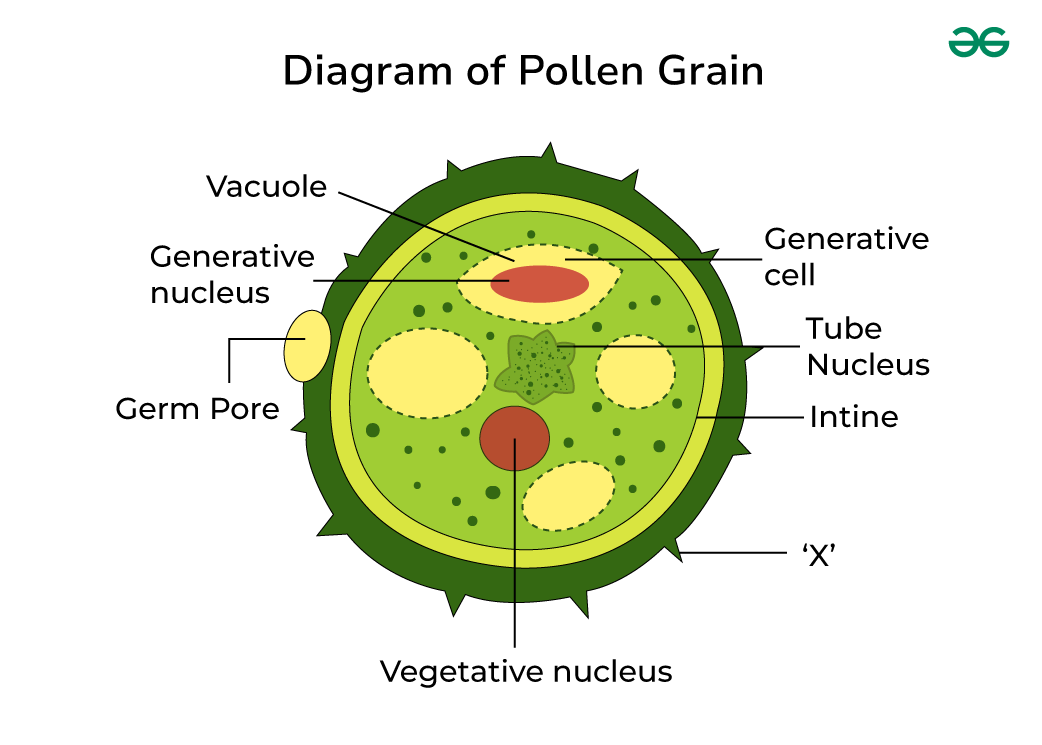
The haploid nucleus undergoes mitosis to produce two nuclei: a generative nucleus and tube nucleus
The generative nucleus producers to male nuclei by mitosis
When the pollen is mature
outer layers
opening
The outer layers of the anthers dry out causing tension in lateral grooves
eventually occurs in which the tension pulls the walls of the anther apart and the edges of the pollen sacs curl away
The opening called stoneium exposes the pollen grains and they are carried away by insects or wind
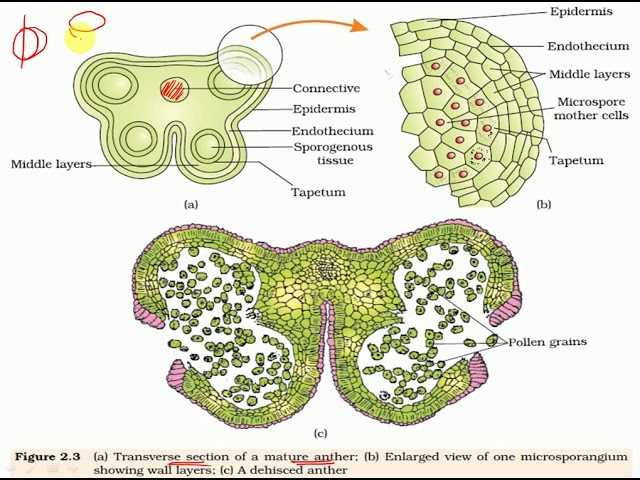
Development of the female gamete
the ovary contains one or more ovules
in each ovule: a mega-spore mother cell undergoes meiosis making 4 haploid cells
3 disintegrate
the remaining cell undergo 3x mitosis, producing 8 haploid nuclei (1 is female gamete)
two of the haploid nuclei fuse to make a diploid nucleus, called polar nucleus
Purpose of the nuclei
surrounded by nucleus
The nuclei are in the embryo sac surrounded by the nuclleus, a layer of cells which provide nutrients
around the nucleus are two layer of cells integuments. a gap in the interguments is the micropyle
As with the formation of the male gamete that type of cell division that directly produces the female gametes mitosis

8 nuclei form
One forms the haploid female gamete
Two form the haploid synergids
Two will fuse to form a polar nucleus that is diploid.
Three form 3 antipodal nuclei.
ovule diagram
Pollination
of the same species
The transfer of pollen grains from the anther to the mature stigma of a plant of the same species
postandry
The stamens of the flower ripen before the stigmas
self and cross pollination
self pollination: The pollen from the anther of the flower is transferred to the mature stigma of the same flower or another flower on the same plant
cross pollination: pollen is transferred from the anther of one flower to the mature stigma of another flower on another plant of the same species
self pollination leads to
genomes of gametes
self fertilisation- resluts to inbreeding
self fertilized species depend only on independent assortment and crossing over during meiosis and on mutation to bring about genetic variation in the genomes of the gametes. They display less genetic variation than cross fertilized species
greater chance of two potentially harmful recessive alleles being brought together at fertilization
the advantage of inbreeding is that it can preserve those successful genomes that are suited to a relatively stable environment
Cross pollination can lead to
evolutionary signficabce
Cross fertilization- results in outbreeding
outbreeding combined gametes from two individuals, in addition to events in meiosis and mutation, and so it generates more genetic variation
outbreeding reduces the chance of producing harmful allele combinations
outbreeding is of great evolutionary significance, because in a particular environment some genomes are more successful than others. It may allow a species to survive in a changing environment as there are always likely to be some members of a population with suitable combination of alleles
Ensuring cross pollination
dichogamy, protandy, protogyny
anther is below
genetic incompatibity
sepreate
Dichogamy: eg. Protandy. Or protogyny (stigma opens first)
the anther is below the stigma so pollen cannot fall onto it eg. Pin eyed primrose
genetic incompatibility eg. red clover. pollen cannot germinate on the stigma of the flower that produced it
separate meal and female flowers on the same plant eg. Maizev
separate male and female plants eg. Holly
Fertilisation
fusion
The Fusion of a female and male gamete
producing a zygote
After pollination
up a gradient of
When a compatible pollen grain lands on the stigma, it germinates in the sucrose solution secreted by the stigma and produces a pollen tube
the pollen tube nucleus is at the tip of the tube with two male nuclei behind
the pollen tube grows out of the pollen grain through a gap in the cell wall (Pit) and down the style up a gradient of chemoattractants
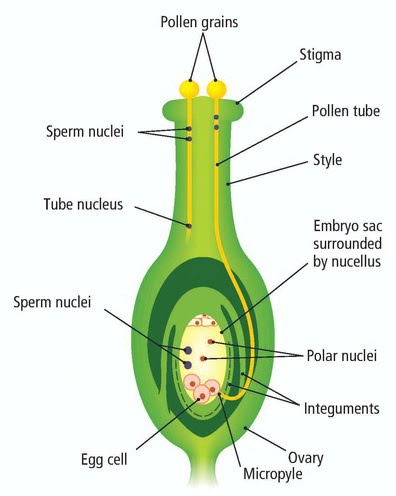
Tube nucleus
codes for production
pollen tn disentegrates
The pollen tube nucleus codes for the production of hydrolases including cellulases and proteases, and it digests its way through the tissues of the style. The products of digestion are used by the growing pollen tube
the pollen tube grows through the gap in the integument, the micropyle and passes into the embryo sac
the pollen tube nucleus disintegrates, presumably having completed its function of controlling the growth of the pollen tube
Two male gametes released
tip of the pollen tube opens
The tip of the pollen tube opens, releasing the two male gametes into the embryo sac
the male and female gametes are haploid one of the male gametes fuse with the female (the oosphere), to form the zygote, which is diploid
the other male gamete fuses with the diploid polar nucleus to form a triploid nucleus. This triploid nucleus is the endosperm nucleus. When it divides repeatedly by mitosis, it generates the endosperm tissue which takes over from the nucleus in providing nutrition for the developing embryo
Double fertilisation
Starts when the pollen tube grows through the gap
Fusions have occurred to form the zygote and to form the endosperm
Fruit, structure d
ovary wall
A structure developing from the ovary wall, containing one or more seeds
Seed
fertilized ovule
Structure developed from a fertilized ovule, containing an embryo and food store enclosed within a testa
Development of the seed
zygote endosperm integuments
micropyle
Diploid zygote divides by mitosis, becoming an embryo which consists of a plumule ( developing shoot) a radical ( developing root) and one or two cotyledons (seed leaves)
Triploid endosperm nucleus develops into a food store, providing food for their developing embryo
outer integuments to dry out, harden and become waterproof, with deposits of ligon they become the seed coat/testa
the micropyle remains as a pore in the seed

Development of the seed
ovule
funicle/stalk ovary
Ovule comprising the embryo, enfosperm and testa becomes the seed
funicle or stalk of the ovule becomes the funicle of the seed, it attaches to the seed at the hilum
the ovary becomes the fruit [in cherries the ovary wall become sweet juicy and pigmented] [in almonds the ovary wall becomes dry and hard]
Structure of the fruit and seed
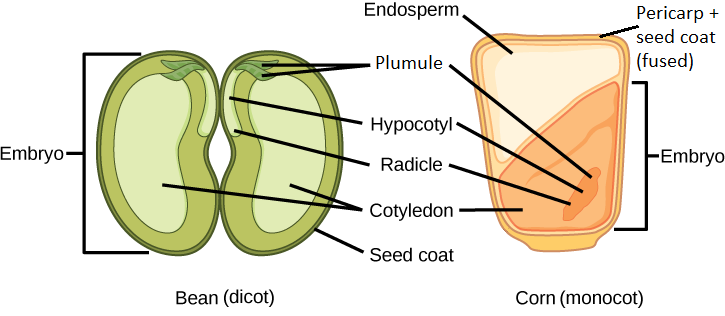
Dicotyledon
Eg. Broad beans
Its seeds have two seed leaves or cotyledons. The embryo lies between them
the endosperm (which was the food store for early embryo) is absorbed into their cotyledons, so the broad bean has a non endospermic seed
Monocotyledon
Eg. Maize
it's only has one cotyledon
the endosperm remains as the food store, so maize seeds are endospermic
the cotyledon remains small and does not develop further. The testa of a maize seed fuses with the ovary wall, so maize has one seeded fruit
seed becomes dormant, water content falls below 10% and reduces their metabolic rate
They can survive long periods and will not germinate until conditions are suitable
Seed dispersal
The movement of seeds away from the parent plant
these seeds produce plants which avoid competition
dispersal methods have been subject to natural selection
Seed dispersal method
wind
Ash and Sycamore fruits have sales to allow wind dispersal
Dandelion fruits have parachutes of stiff hair
the fruit of poppies has pores, through which the seeds are shaken out when the stem is blown in the wind
Seed dispersal method,
scarification
transport
A birds eat seeds that pass through the digestive system and are dispersed in faeces
mammals, Reptiles and fish can also disperse seeds this way
Scarification - the digestive system weakens the testa by physical attack by acid and by enzymes and the seeds of some species can only germinate when this happens
seed dispersal method
rolling
When the fruit of a horse chestnut tree breaks open, the conker, falls to the ground and rolls away from the parent tree
Seed dispersal method
bursting
When Lagoon pods dry they split and the seeds scatter
in many species the pods rotate as they burst open sending the seeds in different directions
Seed dispersal method
water
Coconut palms grow by water
coconuts are seeds and when they fall into the water, they float, because the air cavities make them buoyant and the water carries them
Seed dispersal method
carrying
Hooked seeds attached to animals coats and are carried away
Seeds and survival
Dormant seeds
the testa is chemically resistant
the water content
the testa
the endosperm of cotyledons
seeds can be dispersed
dispersal allows colonization
inhibitors
Dormant seeds have a low metabolic rate and so they survive cold weather
the testa is chemically resistant, so seeds survive adverse chemical conditions
the water content of a dormant seed is produced below 10% and so seeds can survive very dry conditions
the testa can physically protect the embryo
the endosperm of cotyledons provide a supply of nutrients which last until the emerging seedling can photosynthesize adequately
seeds can be dispersed great distances from the parent plant and don't compete with it
dispersal allows colonization of new habitats
inhibitors may allow germination at suitable times of the year. They are broken down in cold weather ( vernalization) so that the seed can germinate in spring
Germination
biochemical and physiological
The biochemical and physiological processes through which a seed becomes a photosynthesizing plant
Conditions for successful germination
suitable temp: optimum temp for germination is the optimum for the enzymes in the process. usually between 5-30 degrees
water: to mobilise enzymes, for transport in the xylem and phloem and to vacuolate cells, making them turgid
oxygen: aerobic respiration releases energy, which fuels metabolism and growth
Mobilisation of food reserves and germinatiorn
when conditions are suitable
When conditions are suitable, water is taken up or “inbribed” rapidly by the seed through the micropyle. Water causes the tissues to swell and provide suitable conditions for enzymes activity
Mobilisation of food reserves and germination
food reserves in the seed
Food reserves in seeds are insoluble in water and can't be transported to the embryo
The reserves must be broken down into soluble molecules. amylase hydrolyes starch into maltose and protease hydrolyes proteins to amino acids
Te soluble products are transported to the embryo and carried in the phloem to the plumule and radicale, where rapid cell division occurs
some of these sugars are converted to cellulose for cell wall synthesis
aerobic respiration releases energy from sugars and amino acids are used for protein synthesis
Mobilisation of food reserves and germination
swollen tissues
The swollen tissues rupture the testa and the radicale emerges from the seed. It is positively geotropic and negatively phototropic and so it grows downwards
then the plumule emerges it is positively phototrophic and negatively geotropic so it grows upwards
Mobilization of food reserves and germination
the part of the plumule
During germination the cotyledons of the broad bean remain below ground
the part of the plumule above the join between the embryo and the cotyledons elongate rapidly, pushing the plumule upwards
the plumule is bent over in the shape of a hook as it's pushes its way up through the soil. This protects the tip from damage of soil abrasion.
Mobilisation of food reserves and germination
if the seed has been planted
If the seed has been planted at the correct depth in the soil, when the plumule emerges, the hook straightens and the leaves unfurl and begin to photosynthesize
By now the food reserves in the cotyledons will have been depleted
The brewing industry
Uses germinating barley seeds to make beer
terms “malt” and “Malting” used in brewing refers to the maltose generated when the starch in barely is digested
Gibberellin process
Barley embryo secretes a plant growth regulator: gibberellin, which diffuses through the endosperm to the aleurone layer. a layer has a high protein content
the gibberellin switches on genes in the cells of the aleurone layer, resulting in transcription and translation producing enzymes including protease and amylase
the proteases hydrolysed protein in the aleurone layer to amino acids, which are used to make amylase and maltase
the carbohydrates's diffuse out of the aleurone layer and hydrolyze the starch stored in the endosperm cells
the sugars produce diffuse back through the endosperm to the plumule and radicale of the embryo
sugars are aspired for energy which fueled bio synthesis and cell division bringing the seed out of dormancy
The male reproductive system
major organs
A pair of testes which produce sperm. They are contained in an external sac: the scrotum.
Vas Deferens which transports sperm from the testes to the penis.
Glands (prostate, seminiferous tubules and the cowpers gland) which add fluid.
Penis filled with spongy tissue which allows sperm to be placed inside the female.
testes to van deferens
each teste contain, cells lining reaches
vas efferentia
Each testis contain seminiferous tubules. These cells lining the tubules undergo spermatozoa formation and throughout the process, cells move towards the lumen. running through the middle of the tubule
When the sperm reaches the lumen, they move through the tubule and collect in the Vasa efferentia.
They carry sperm to the head of the epididymis. Sperm remain in the epididymis for a short time while they become motile and then pass into vas deferens during ejaculation.
Vas deferens to penis
on the way, seminal vesicles
Vas deferens carry sperm from the epididymis towards the penis
on the way, the seminal vesicles secrete mucus into the vas deferens.
The mucus contains a mixture of chemicals including fructose, respired by the sperm for energy. The sperm and seminal fluid move through the ejaculatory duct, which passes through the prostate gland.
Where's zinc containing prostate fluid is secreted
the fluid emerging from the prostate gland is semen: mixture of sperm and seminal and prostate fluids. It's carried through the penis in the urethra.
The secretions of accessory glands are alkaline
They:
maintains sperm mobility
provides nutrients to the sperm, including fructose, amino acids and zinc ions
neutralise the acidity of any urine remaining in the urethra
neutralise that acidity of the vaginal tract
Gametogenesis
Production of gametes in the sex organs
spermatogenesis is the formation of sperm in the testis
Spermatogenesis process
Cells of the germinal epithelium are diploid. They divide by mitosis to make diploid spermatogonia and more germinal epithelium cells
spermatogonia divide by mitosis to form diploids primary spermatocytes
primary spermatocytes undergo meiosis, making secondary spermatocytes which are haploid
secondary spermatocytes undergo meiosis ll to make haploid spermatids
spermatids mature into spermatozoa/ sperm
Sperm structure
enzymes used
from centrioles
the head contains a haploid nucleus, covered at the anterior end by a lysosome {acrosome} This contains enzymes used at fertilisation
the middle is packed with mitochondria, provided ATP for movement. they spiral around the microtubues, which extend from the centrioles into the axial filament in the tail.
the tail/flagellum, makes lashing movements that move the sperm
Female reproductive system
ovaries
There are two ovaries, attached to the body wall below the kidney
oocytes mature in follicles, which develop from cells in the germinal epithelium, around the periphery of the ovary
mature follicles migrate to the surface of the ovary, from where a secondary oocyte is released at ovulation
the ovaries alternate each month in releasing the oocyte
Female reproductive system female reproductive system
fallopian tube
Cilia at the entrance of the oviducal funnel sweep the secondary oocyte into the oviduct/fallopian tube
Ciliated epithelial cells lining the oviduct convey the secondary oocyte into the uterus
The uterus wall
The perimetreum is a thin layer around the outside
the myometrium is the muscle layer
the endometrium is the innermost layer it is a mucous membrane which is well supplied with blood. It is the layer that builds and is shed in a monthly cycle
the embryo implants in the endometrium
the uterus opens into the vagina, through a narrow ring of connective tissue and muscle (the cervix)
the walls are muscular and open at the vulva
Uterus diagram
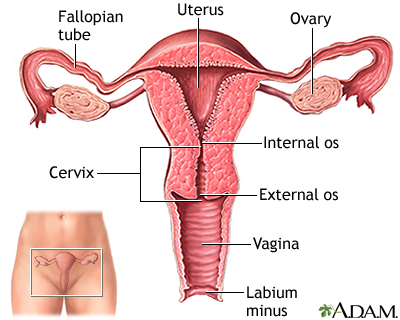
ovary diagram
ovary structure
Germinal epithelium on the outer edge, which produces the egg cells.
Underneath the epithelium in the cortex of the ovary, which will contain eggs in various stages of maturity.
Graafian follicle
Theca produces the female sex hormone oestrogen.
It is stored in the developing cavity called the antrum.
Granulosa cells surround the wall of the follicle and the maturing ovum.
Surrounding the oocyte is a layer of carbohydrate called the zona pellucida.
Oogeesis
oocyte
the formation of secondary oocytes in the ovary
Oogenesis process
In the developing features, diploid Germinal epithelium epithelium divide by mitosis to make diploid oogonium
they divide by mitosis and enlarge making diploid Primary oocytes, and more oogonia
the primary oocytes begin meiosis l
geminal epithelium cells divide to form diploid follicle cells, which surround the primary oocytes, making primary follicles
secondary oocytes are formed when meiosis l completes (contains most of the cytoplasm) the other product is the first polar body, both haploid
the primary follicle develops into a secondary follicle (graffian follicle when it's mature) it migrates to the surface of the overary where it bursts and releases the secondary oocyte ovulation
the secondary oocytes begins meiosis ll but stops at metaphase ll unless fertilization takes place
at fertilisation meiosis ll is complete, making an ovum (containing most of the cytoplasm) the other product is the second polar body
after ovulation the graafian follicle becomes the corpus luteum
Zona pellucida
glycoprotien layer
secondary oocyte
periphery of cytoplasm
Is a glycoprotein layer
it surrounds the cell membrane of the secondary oocyte
the chromosomes of the secondary oocyte are at metaphase ll. They are at the equator attached to the micro tubules that make the spindle apparatus
the periphery of the cytoplasm contains cortical granules which are secretory organelles that prevent the entry of more than one sperm
Corona radiata cell surround the secondary oocytes and provide nutrients
Sexual intercourse
contraction of smooth in the wall
Physical and psychological effects caused the arterioles entering the penis to dilate and the venules leaving to constrict.
The build up of blood in the penis causes it to be erect
movements of the penis results in the contraction of smooth muscles in the walls of the epididymas, vas deferens and penis which causes the ejaculation of semen into the vagina.
The force of ejaculation is sufficient to propel some semen thru the cervix into the uterus
Ejaculation is triggered by the sympathetic nervous system.
causes of erection
Nitric oxide
blood
Erection is caused by the parasympathetic nervous system which causes nitric oxide levels to rise in the spongy tissue of the penis.
The result is that arteries dilate and the blood fills the cavities in the spongy tissue.
Fertilisation
Capacitation, tail, can only
Sperm can only fertilise a secondary oocyte after capacitaion has taken place
It is the removal of cholestorol and glycoproteins from the cell membrane over the acrosome.
The membrane becomes more fluid and more permeable to calcium ions. Meanwhile the tail motion changes to a whipping movement, increasing sperm motility
fertilisation. Acrosome reaction
CR
on contact with zona pellucida
the acrosome release enzymes, which digest the cells of the corona radiata.
On contact with the zona pellucida, the acrosome membrane ruptures and releases more enzymes {protease, acrosin} which hydrolyze the zona pellucida around the secondary oocyte
Fertilisation
sperm head entry
The cell membranes of the secondary oocyte and sperm fuse and the head of the sperm sinks into the cytoplasm of the secondary oocyte
Following the entry the secondary oocyte is called an ovum
Fertilisation. Cortical reaction
Reaction of oocyte
Reaction of the oocyte that produces the fertilization membrane, preventing polyspermy
when the sperm attaches to the secondary oocyte, the oocyte smooth endoplasmic reticulum releases calcium ions into the cytoplasm
They make the cortical granules fuse with the cell membrane and release their contents of enzymes by exocytosis
The zona pellucida is chemically modified and expands and hardens making a fertilization membrane which is impossible for more sperm to penetrate
Fertilisation
meiosis ll
Entry of the sperm also stimulates the completion of the second meiotic division of the ovum nucleus
It proceeds through anaphase ll and telophase ll, divides and expels the second polar body
Fertilization
zygote
Within about 24 hours, the first mitosis combines the genetic material of the parents to make the diploid cells of the embryo
The chromosomes joined the ovum chromosomes on the cells equator
the cell is now a zygote as the chromosomes have combined
Implantation definition
The sinking of the blastocyt into the endometrium
Trophoblast
Cells forming the outer layer of the blastocyt
Implantation
Has the embryo moves down the oviduct, it divides by mitosis in a sequence called cleavage
a solid ball of 16 cells called morula forms within three days
cleavage continues and the cells move in relation to each other
by 7 days, the ball of cells becomes hollow and is a blastocyt
the cells around the outside of the blastocyts are trophoblasts: they divide to make an inner cell mass on one side
the blastocyts moves from the oviduct into the uterus
After ovulation
The endometrium thickens and gets an increased blood supply to prepare it to receive an embryo
there is an “implantation window” where the endometrium is receptive between 6 and 10 days after ovulation
Trophoblastic villi
After about 9 days, protrusions from the trophoblast cells of the blastocsyt called trophoblastic villi
they penetrate the endometrium
the villi increase the surface area for the absorption of nutrients from the endometrium
The placenta
it connects the embryo and then the foetus to the uterus wall
made of tissues derived from the embryo and the mother
Formation of the placenta
The trophoblast develops into the chorion, an outer membrane surrounding the embryo.
cells of the chorion move into the trophoblastc villi and form chronionic villi.
They acquire blood cappilaries,which are connected to the umbilical arteries and vein. They are the blood vessels that connect the embryo to the uterus wall thru the umbilical cord.
Projections from the endometrium between chorionic villi are the maternal tissues of the placenta
roles of the planceta
endocrine organ
produces hormones to support the pregnancy
HCG
Oestrogen, progesterone
Roles of the placenta
exchange between mothers and foetus blood
includes nutrients, waste, products, respiratory gases.
inter villous spaces (lacunae) containing the mothers blood, surround the chorionic villi.
chroionic villus cells have microvili, giving a large area of contact with the mothers blood, for max exchange.
the embryos and mothers blood do not make contact
the concentration gradient between the two circulations is maintained by a countercurrent flow, enhancing exchange efficiency
Role of the placenta
physical barrier
Between the fetal and maternal circulation
protect the fragile fetal capillaries from damage by the higher blood pressure of the mother
protect the developing fetus from changes in maternal blood pressure
Role of the placenta
passive immunity
Provides passive immunity to the fetus; maternal antibodies cross the placenta and attack pathogens but do not attack the fetal cells
Role of the placenta
protection from the mother's immune system
migratory imune cells
The mother does not make an immune response against the fetus or placenta even though they contain foreign genes
the cells of the wall of the choreonic villi fuse so there are no spaces between them making a syncitium. Migratory immune cells cannot get through to the fetal blood
Why placenta may not always provide complete immunological protection
spontanous abortion
rhesus disease
2nd trimester
Some spontaneous abortions are equivalent to the rejection of a transplanted organ
Rhesus disease in a fetus is the destruction of its blood cells by antibodies made by a rhesus negative mother against the blood cells of a rhesus positive feotus
in the second trimester some women develop pre-eclampsia when they have very high blood pressure one cause is an abnormal immune response towards the placenta
The menstrual cycle
detaches
In the absence of an implanted embryo, the endometrium is shed through menstruation
from the first period to menopause
the endometrium detaches if a blastocyst has not been implanted
the endometrium has a good blood supply and it appears as bleeding as it leaves the body
The hormones in the menstrual cycle
Follicle stimulating hormone FSH
luteinising hormone LH
oestrogen
progesterone
FSH
Secreted from the exterior pituarity gland
stimulates the development of primary follicles in the ovary
It forms a fibrous outer layer (the theca) and secretes fluid into a cavity the (antrum)
stimulates the thecal cells to produce estrogen
LH
anterior pituraity gland
Which is its maximum concentration just before ovulation
induces ovulation
it's high concentration causes the graafian follicle at the surface of the ovary to release the secondary oocyte.
Has a positive feedback effect on FSH
the remains of the graafian follicle converts into the corpus luteum- which secretes estrogen and progesterone
these inhibit further secretion of FSH and LH and their concentrations decrease
Purpose of oestrogen
Triggers the rebuilding of the endometrium, which was shed during menstruation
inhibit FSH secretion by negative feedback, which brings its own concentration down again
stimulate LH production by positive feedback
Oestrogen and progesterone
The corpus luteum secretes estrogen and progesterone
the progesterone maintains the newly built endometrium so that if a secondary oocyte is fertilized, there will be suitable tissue in which the embryo can implant.
If if there is no fertilization or implantation, the falling concentrations caused the corpus luteum to degenerate so oestrogen and progesterone production declines
The endometrium is no longer being rebuilt by estrogen or maintained by progesterone and is shed
As oestrogen and progesterone are low
They know they no longer inhibit FSH production, so cycle restarts
The amnion
The embryo develops and grows in the uterus enclosed in the amnion- a membrane that is derived from the inner cell mass of the blastocyst
amniotic fluid accumulate and increases in volume for 6 to 7 months
the fluid is made by the mother and the fetus contributes urine to it
the fluid pushes the amnion out
Purpose of amniotic fluid
Maintains foetus temperature
provides lubrication - if too little amniotic fluid circulates between fingers and toes, they may become webbed
contributes to lung development
allows movement so muscles and bones function before birth
acts as a shock absorber protecting the fetus from injury, from outside the uterus
1st trimester
1st trimester ~
(3 months)
conception, implantation and embryogenesis.
All major organs are laid down.
Most prone to miscarriage.
2nd trimester
Becomes called the foetus
3-6 months.
Nervous system begins to function.
Eyes begin to move
Limbs begin to move.
3rd trimester
6-9 months
all major structures are complete
Period of growth
fat laid down, foetus mass anf length increases
By 28 weeks high survival rates for premature birth.
Massive increase in scope of nervous system.
Human Chorionic Gonadotrophin (HCG)
It maintains the follicle in the ovary form a structure called the corpus luteum.
HCG maintains the corpus luteum in making progesterone, which maintains the endometrium.
placental hormones
Produced first by the corpus luteum and by three months on by the placenta.
This maintains the endometrium.
Increases breast development.
Inhibits other hormones (FSH, LH, Prolactin and oxytocin)